Jewelry
boxes and cabinets

Request
current list of available Jewelry boxes.
writing-boxes
jewelry-boxes
tea caddies
sewing-boxes
contents
| |
\
Antique 18th C with rare marquetry showing force and beauty of a living plant:
art in wood circa 1790.
Please click on images to enlarge | slide show | thumbnail index |Request
current list of available Jewelry boxes.
Reference: JB431
Description:
JB431: A rare and striking box made by a gifted craftsman who had a truly artistic instinct for the materials at his disposal. Patterns are created by different woods, which mutually enhance and compliment the varied qualities of the timbers, resulting in an object the beauty of which is wholly created by projecting organic natural growth. The faint straight grain of the background veneer is an unobtrusive background which allows the dramatic centre to make a bold and striking statement: the force and beauty of a living plant. The box has a replacement tray with supplementary lids. Circa 1790.
Origin: UK
Circa: 1790
Size: 31.5 cm wide by 24.5 cm by 14 cm: 12.4 inches wide by
9.7 inches
by 5.5 inches.
Condition:
Tiny old repair under left quarter inlay. If
minutely examined, small scratches and losses. Interior added. Working lock and
key.
|
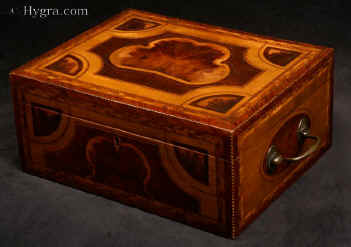
Although the box is not in the distinctive Tunbridge ware
designs of slightly later work, it has many characteristics attributable to pre
formulaic Tunbridge ware (use of yew, central growth patterns, ovals, juxtaposed
timbers) and it definitely shows an artistic/craft genius at work. Occasionally
this exceptional quality is found in tea caddies of the period; boxes are rarer.
|
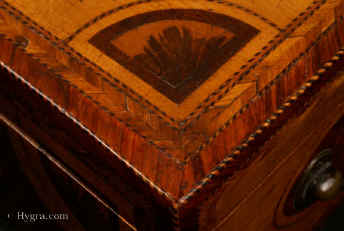
|
Detail: the corners are inlaid with marquetry in triangular segments. This is made of
quarter-cut sapwood which shows sharp growth patterns, which are smaller, but
complementary to the main central design.
|
Please click on images to enlarge | slide show | thumbnail index |Request
current list of available Jewelry boxes.

|
The front and top centres of the box are inlaid with
book-matched yew sapwood veneers. These create a bold pattern, the dark middle
getting darker before bursting out into the lighter outer wood in lively patters
which end in sharply defined jagged lines. The central inlays are set in a frame
of harewood edged in fine plain and rope- twist stringing.
|
The sides are veneered in maple and edged in the same
patterns as the top and front. They are decorated with ovals of burr yew, the
knotted figure of which livens up the surface and provides a good background to
the original strong drop-down brass handles.
|
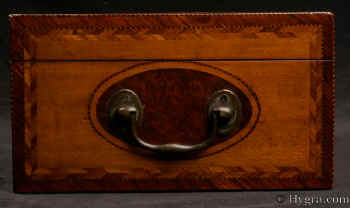
|
Please click on images to enlarge | slide show | thumbnail index |
The back is in maple, edged in matching patterns and
decorated with two smaller ovals in tulipwood.
|
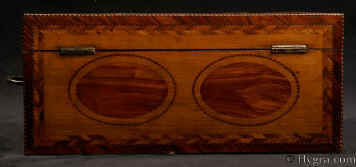
|
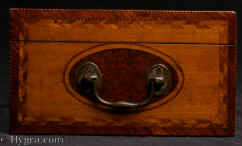
|
The sides are veneered in maple and edged in the same
patterns as the top and front. They are decorated with ovals of burr yew, the
knotted figure of which livens up the surface and provides a good background to
the original strong drop-down brass handles.
|
Please click on images to enlarge | slide show | thumbnail index |Request
current list of available Jewelry boxes.
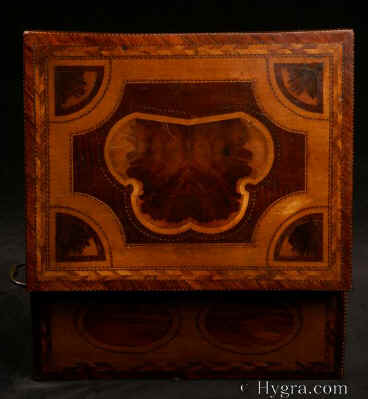
|
The top of the box is veneered in light coloured satinwood
and edged in slanted kingwood and herringbone lines. The two edging bands are
separated by rope twist lines in ebony and boxwood. The veneers are thick
saw-cut veneers and over the last two hundred years they have shrunk and
expanded in slightly different ways, resulting in a surface which has the
natural beauty of a ‘living’ object.
The top central inlay is suggestive of a leaf pattern,
which reinforces the impression of bursting life and energy implicit in the
growing wood. The corners are inlaid with marquetry in triangular segments. This is made of
quarter-cut sapwood which shows sharp growth patterns, which are smaller, but
complementary to the main central design.
The front and top centres of the box are inlaid with
book-matched yew with light sapwood and dark heartwood veneers. These create a bold pattern, the dark middle
getting darker before bursting out into the lighter outer wood in lively patters
which end in sharply defined jagged lines. The central inlays are set in a frame
of hare wood edged in fine plain and rope- twist stringing.
|
The central inlays are set in a frame
of hare wood edged in fine plain and rope- twist stringing.
The central pattern: book-matched yew
with light sapwood and dark heartwood
|
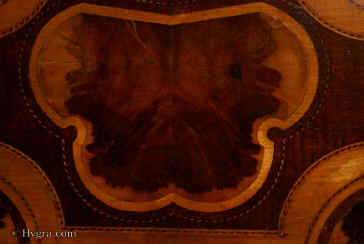
|
Please click on images to enlarge | slide show | thumbnail index |
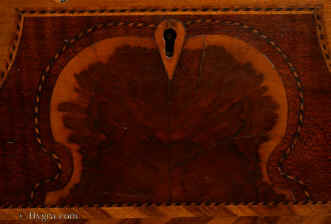
|
The central inlays are set in a frame
of hare wood edged in fine plain and rope- twist stringing.
The central pattern:
book-matched yew with light sapwood and dark heartwood.
|
Please click on images to enlarge | slide show | thumbnail index |Request
current list of available Jewelry boxes.
The box has a replacement tray with supplementary lids.
|
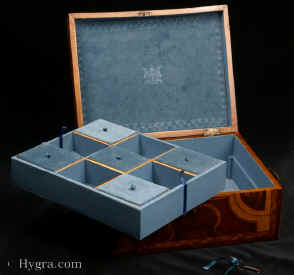
|
Please click on images to enlarge | slide show | thumbnail index |
All text and images and linked images are ©
1999-2009 Antigone Clarke and Joseph O'Kelly. If you require any further
information on permitted use, or a licence to republish any material, email us
at copyright@hygra.com
|
